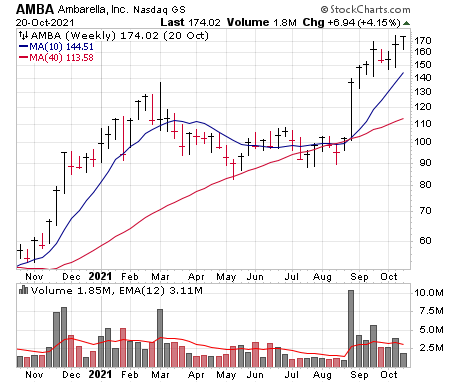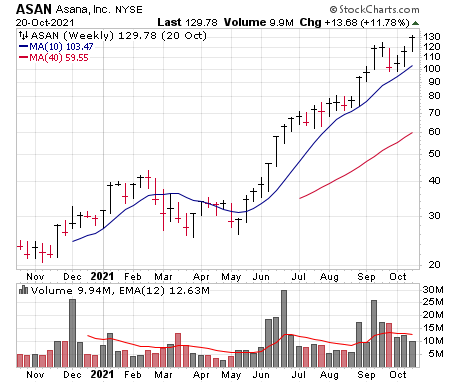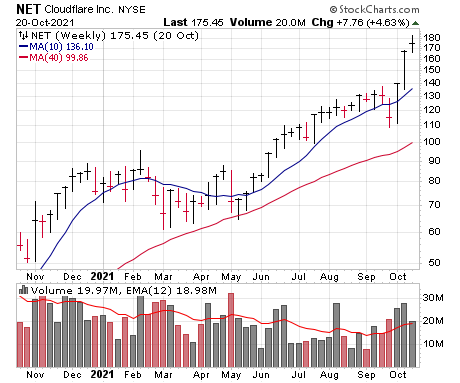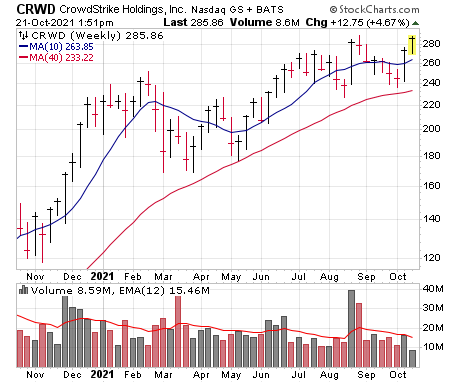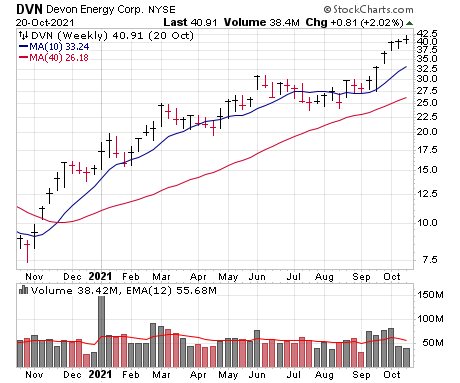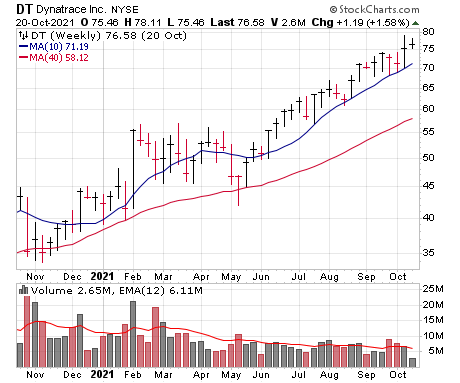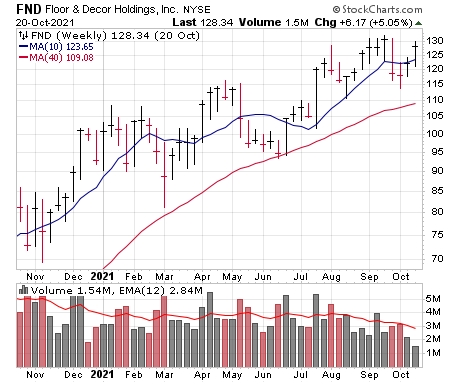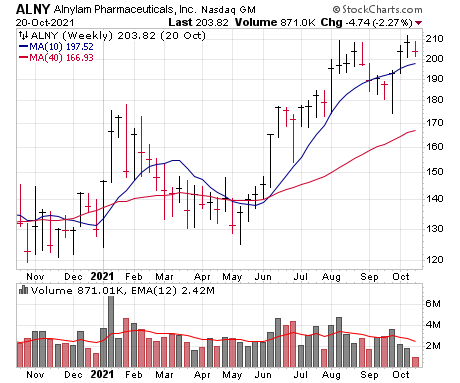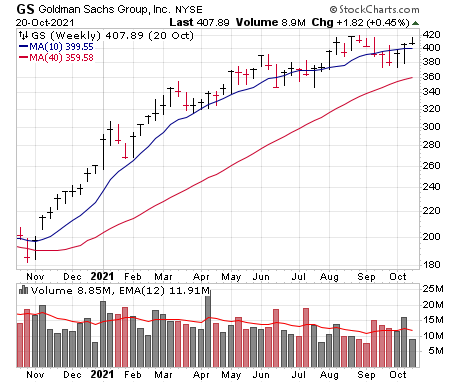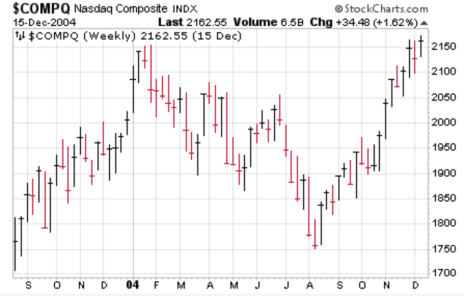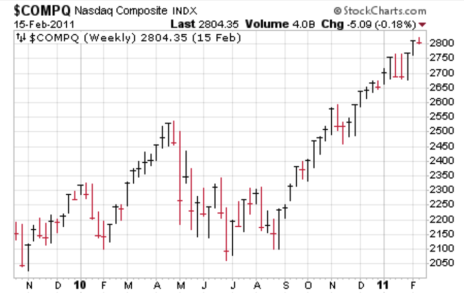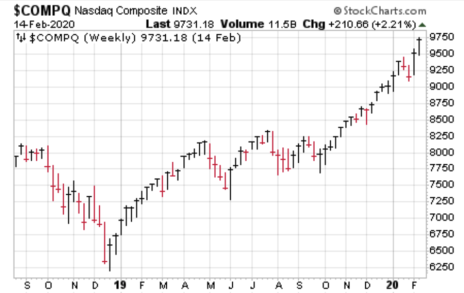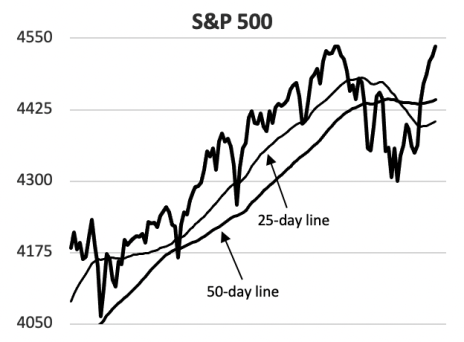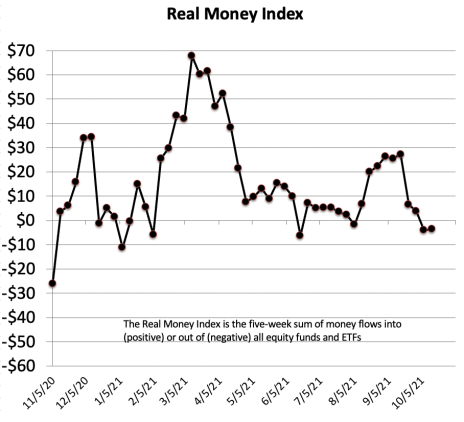[premium_html_toc post_id="239713"]
The Leaders are Speaking
When asked to explain our market timing system, we usually focus on our trend-following indicators, and for good reason—they’re the backbone of our methodology, essentially guaranteeing we’ll never be heavily invested during a prolonged downtrend, nor will we stay on the sidelines during a big bull run. No set of indicators is perfect, but having been here 22 years, I can tell you just staying on the right side of the market’s trends (yes, even battling through some whipsaws) will put you ahead of 80% of investors.
However, except for the occasional leveraged long index fund, we generally don’t invest in the major indexes—we invest in leading growth stocks that have great stories, numbers and charts. And that leads us to the second key piece of our timing: The action of the leaders, which is harder to define but is vital for your portfolio’s health.
Last year, for instance, leading stocks were soaring all over the place despite sluggish action from many big-cap indexes—that was a reason we were heavily invested for much of the post-crash run and made big money. This year, though, despite a resilient Dow and S&P 500, leading growth titles have been hit or miss at best, with most that we track suffering at least one deep, multi-month correction so far this year.
But now that looks to be changing—while some select growth stocks have had their moments in the sun this year, the action since the early-October low has been eye opening, with many leaders we own and watch racing higher on big volume. Said another way, the leaders are finally leading! And, getting back to the overall market, other stuff is participating, too; gone, at least for now, is the rotational environment, replaced by a vacuum of selling pressures that has allowed most everything to perk up.
So is the market totally out of the woods? We can’t say that quite yet for two reasons. First, while our Cabot Tides have returned to positive territory, most indexes are still stuck in the same ranges they’ve been in for months. Plus, a bunch of leaders are reporting earnings in the next couple of weeks, and we all know the risks there.
What To Do Now
Still, the action of the past couple of weeks (combined with many signs that investors have become worried) certainly looks like a bullish change of character. We wouldn’t be buying whole-hog, but we’re putting some more of our cash hoard to work—in the Model Portfolio, we’re averaging up on Asana (ASAN) and buying a full-sized position in CrowdStrike (CRWD), leaving us with a cash position of 24%.
Model Portfolio Update
Two weeks ago the major indexes were sitting near their correction lows, but many growth stocks—including a few we owned—were holding well, forcing us to keep most of our Buy ratings intact. And now that the pressure has come off the indexes and our Cabot Tides have returned to bullish territory, growth stocks are shining like they haven’t since the very start of the year, with many racing back toward (or above) their prior highs.
Now, it’s not 1999 out there—the 10-day average of stocks hitting new highs is still near 12-month lows, and while our Cabot Tides are positive, there’s no doubt many sectors and even indexes are still stuck in tedious ranges. Throw in the fact that dozens of earnings reports from growth stocks are coming up and we don’t advise going hog wild.
But there’s no doubt the evidence has greatly improved, so we’re taking a couple of steps into the market, adding more ASAN and taking another swing at CRWD. That will leave us with 24% in cash, which we hope to deploy in some fresh earnings winners, assuming the market’s mood remains positive.
Current Recommendations
| Stock | No. of Shares | Portfolio Weightings | Price Bought | Date Bought | Price on 10/21/21 | Profit | Rating |
| Ambarella (AMBA) | 655 | 5% | 166 | 10/14/21 | 177 | 6% | Buy a Half |
| Asana (ASAN) | 1,354 | 7% | 73 | 7/22/21 | 136 | 88% | BUY ANOTHER 3% POSITION |
| Cloudflare (NET) | 1,790 | 13% | 113 | 6/25/21 | 182 | 61% | Buy |
| CrowdStrike (CRWD) | New Buy | New Buy | - | - | - | - | Buy |
| Devon Energy (DVN) | 7,240 | 13% | 28 | 5/7/21 | 40 | 41% | Buy |
| Dynatrace (DT) | 3,114 | 11% | 65 | 8/6/21 | 78 | 19% | Buy |
| Floor & Décor (FND) | 1,845 | 10% | 111 | 4/9/21 | 135 | 21% | Buy |
| ProShares Ultra S&P 500 (SSO) | 871 | 5% | 60 | 5/29/20 | 134 | 123% | Buy |
| CASH | 840,689 | 37% |
Ambarella (AMBA)—We’ve never been huge fans of chip stocks, as many can turn tail in a hurry based on industry or competitive factors, but usually you’ll see a glamour name in the group enjoy a huge run when they come up with a unique solution for a growth industry. Ambarella fills that bill today, with years of R&D resulting in computer vision chips that are perfectly suited for smarter automobiles (newer models have tons more cameras) and security cameras. While they’re still the minority of revenue, these chips are growing rapidly and Q2 (reported at the start of September, so the next report won’t be out until late November/early December) was a coming-out party in terms of investor perception. Near term, another wobble or two from this volatile name wouldn’t shock us, but it’s likely that the September blastoff will lead to good things down the road. We started with a half-sized position (5% of the Model Portfolio—see more later in this issue about how we run the portfolio) last week and will look to buy more if the stock and market continue to act well. If you don’t own any, we’re fine picking up some shares here or on dips of a few points. BUY A HALF
Asana (ASAN)—ASAN wasn’t unscathed by the market’s correction, falling from 125 to 100 over just six days late last month, but the buyers have plowed back in (with the help from another big insider purchase from the CEO near that 100 level), helping the stock to notch new highs this week—all of which is to the good. The trick here is managing the position; we only bought a half-sized stake a few months ago and never bought more for various reasons (mostly the market environment, and the one good-looking entry came right before earnings). Thus, we’d like to average up in what is one of our strongest stocks (and one of the best-looking new leaders out there) … but because of the stock’s big move, it’s become 7.5% of the account. We don’t want to make it too complicated, but long story short, we’re going to fill out our position in ASAN by purchasing another 3% position, which will effectively leave us with a full-sized stake. BUY ANOTHER 3% POSITION
Cloudflare (NET)—We’ve been at this game for well over two decades and have seen all sorts of “never seen before” events in the market and individual stocks. But Cloudflare’s recent action is right up there among the most unusual (in a good way) clusters of action we can remember—the stock looked ready for a correction after a spate of big-volume selling in September (falling from 137 to 109), but two weeks ago the stock turned on a dime and it’s rallied north of 180 with hardly any weakness at all! If you’re a pessimist, you could look at the action as a blowoff following NET’s massive run that began early in 2020, but we’re not thinking that way—instead, the rush of buying at a time when the market (and growth stocks) was just emerging from a downturn should portend higher prices, especially as the firm leads the way in many of the fastest-growing areas (website security, content delivery, search acceleration) out there. Hold on if you own some, and if not, aim for dips of a few points to start a position. BUY
CrowdStrike (CRWD)—We owned CRWD earlier this year but it got caught up in the springtime growth stock decline. Now, though, we’re going to take another swing: We continue to think the company has the potential to grow many-fold as it essentially becomes a must-have solution for all sizes of enterprises and even other cybersecurity vendors; its Falcon platform is actually used by Okta to protect its own operations, while the platform is used within Zscaler’s solution and can be integrated into Cloudflare’s broader security offering, too. Beyond the big-picture story is a recent catalyst—last week, the company expanded its product offerings into what’s known as extended detection response technology, moving the company beyond its traditional endpoint device focus; now Falcon will automatically collect and analyze data from a variety of areas (email, endpoint, servers, cloud workloads, etc.), allowing for faster detection of threats. The market liked the news, with CRWD flashing some good-volume buying as the stock raced back to its old high. To be fair, shares haven’t quite broken out yet, and as with many stocks, another wiggle is certainly possible. But there should be solid support not too far below here if we do get another shake, and given the pristine growth numbers (sales expected to rise nearly 40% and earnings 70% next year, both of which are likely conservative), the February-October rest period will prove to be a big launching pad. We’ll buy a full-sized position tomorrow and use an initial loss limit in the 250 area (give or take a few points). BUY.
Devon Energy (DVN)—Big advances in stocks are always fun, but what’s often more revealing is “how” they pull back afterwards—quick, sharp retreats that give back a big chunk of the advance aren’t ideal (we saw that over and over again earlier this year among most growth titles), while tight, grudging declines tell you big investors are hesitant to let many shares go. Happily, DVN is following the latter script, with little desire to pull in yet despite its straight-up run (and it’s a similar story for oil prices as a whole). Obviously, if oil prices do stumble, the group could follow suit short term; plus, with Devon’s dividend announcement coming on November 2, there could be some sell-the-news action after that. But as we wrote in the last issue, we think the tidy launching pads and powerful blastoffs last month (along with the recent resilient action) tell us this oil move in general—and DVN in particular—has further to run. We’ll stay on Buy. BUY
Dynatrace (DT)—Dynatrace will never be a household name, but it’s an increasingly well-known brand among IT heads at big enterprises thanks to its best-in-class cloud transition platform. The stock continues to act well, advancing in relatively smooth fashion, but next week will be key—the company will report earnings next Wednesday (October 27) after the close, with analysts looking for revenue of $221 million (up 31%) and earnings of 16 cents per share, but just as much attention will be paid to the key annualized recurring revenue figure (was up 32% in Q2) and same-customer revenue growth (up 25%). To be fair, the stock has had a good run from its lows in May, so we’re not ruling anything out; a decisive plunge back into the low/mid-60s may have us moving on. But right now the evidence suggests there are few weak hands in the stock (the breakout in June came from a year-long rest) and, fundamentally, years of rapid and reliable growth are coming down the pike. We’ll stay on Buy, but keep any new positions on the small side this close to the report. BUY
Floor & Décor (FND)—We gritted our teeth and kept our Buy rating on FND through its correction, and so far, that’s proven to be the right call, as shares moved straight up of late, including a (low-volume) push to new highs today. Many retail-related names remain under pressure due to supply chain worries and tough comparisons in the second half of this year (as opposed to many firms, Floor & Décor enjoyed boom times in the second half of 2020); for Q3, analysts see revenues for the firm up 25% but earnings flat from a year ago. Still, while anything is possible, we see the odds favoring the big-picture, cookie-cutter story keeping big investors interested barring hints of a prolonged slowdown (more than a quarter or two). The path of least resistance is up, so hold on if you’re already in, though if not, keep new buys small and/or aim for dips if you want in. BUY
ProShares Ultra S&P 500 Fund (SSO)—The rally in the S&P 500 hasn’t set any records or caused any blastoff-ish indicators to flash green, but it’s no doubt been impressive—when looking at SSO, it slipped a net of 10 points over five and a half weeks but has made nearly all of that up in the past five sessions. As we wrote earlier, we can’t rule out another shake lower especially if some high-profile earnings reports disappoint (seems to happen most reporting seasons), but there’s no doubt the action is positive. If you own some and took partial profits earlier like us, we advise just hanging on; we wouldn’t chase your tail, especially if you still have a good-sized position like us. For new buyers, though, we’ll restore our Buy rating, thinking you can grab a position here or on dips. BUY
Watch List
- Affirm Holdings (AFRM 155): AFRM is extraordinarily strong, but also extraordinarily volatile and extended (about 20% above its 25-day line). Frankly, we’re not expecting a major retreat, but prefer to aim for a shakeout or rest period to enter.
- Alnylam Pharmaceuticals (ALNY 204): ALNY has been up and down of late but is perched near its highs ahead of earnings next Thursday. See more later in this issue.
- Dexcom (DXCM 568): DXCM has chilled out for five weeks and is hanging around its 50-day line, which is completely normal action. The trick here is that earnings are due out in a week (October 28)—if shares get through that in decent shape we could enter.
- Snowflake (SNOW 342): SNOW has a big story (and a big valuation), and the stock has pushed to new recovery highs as the market has strengthened. Its Data Cloud could be another must-have solution for big enterprises.
- ZoomInfo (ZI 70): We’ve been keeping an eye on ZI for months, as it has the story and numbers of a fresh software leader, and now the stock is set up for a sustained run—if earnings (due November 1) please investors.
Other Stocks of Interest
Alnylam Pharmaceuticals (ALNY 204)—We had our eye on ALNY back in early August before it corrected, but in true 2021 fashion, it’s come back nicely and is set up well ahead of its quarterly report. Plus, as far as biotechs go, Alnylam’s big-picture story is easy to understand and powerful: The company is the leader in RNA interference technology (RNAi for short), where drugs silence specific genes that can actually cause diseases; the firm has the only RNAi drugs on the market with a bunch more in the pipeline. The biggest draw is Onpattro (approved in the U.S., Europe and six other countries), which treats a disease that impedes periphery nerves and causes debilitating symptoms; revenues reached $114 million in Q2, up 71% from a year ago, yet the drug is being used by just 1,725 of a potential 50,000 patients! Next is Givlaari, which treats a rare genetic disease that sees toxins build up and can cause all sorts of issues; revenues totaled $31 million in Q2 (up 178% from a year ago), and Alnylam thinks the potential market is north of $500 million annually here. Then there’s Oxlumo, used for a rare pediatric disease; it just launched at the start of this year and had $16 million of revenue in Q2 with just 100 patients (potential market here is also north of $500 million). There’s likely to be two more drugs on the market next year (one of which is in partnership with Novartis; Alnylam will get 20% royalties), and the pipeline has four other candidates in Phase II or Phase III trials—all in all, the company sees 40%-plus annual revenue growth through the end of 2025, and bigger than that is the potential for RNAi to help with many rare diseases down the road. As for the stock, it went nowhere for six years (!), but lifted to new highs after the market’s May low, and after a five-week correction, has rebounded nicely. Earnings are due next Thursday (October 28); a positive reaction could be buyable.
Goldman Sachs (GS 408)—If you told us we’d be keeping an eye on Goldman Sachs anytime in the past decade, we would have laughed you out of the room—first off, there was little growth there, and secondly, the stock went nowhere for an incredible 13 years! But the company has always been one of (if not the) favorite Bull Market stocks among the institutional crowd, and with financial stocks having broken free of their long slumber a year ago, GS is a good bet to be a reliable leader on the way up. And this is about far more than just the chart or sector action: After many years of choppy earnings results (the bottom line rose only from $18 per share in 2015 to $21 per share in 2019), business has mushroomed the past two years, with Wall Street looking for earnings of $58 this year! Not surprisingly, investment banking is leading the way, with earnings in that segment up 290% in the recently reported Q3, while consumer and wealth management (up 38%) and asset management (up 30%) earnings also seeing good gains versus tough comparisons in 2020. To be fair, most believe 2021 will be a near-term peak year for the company; analysts see earnings slipping to around $40 per share next year, but (a) that’s still a ton of dough and (b) we’re not sure how seriously to take these estimates given that Goldman has been topping expectations by massive amounts every quarter. Beyond the numbers, though, is the fact that, as long as the market gains steam and money is relatively loose, it’s a pretty good bet that Goldman will thrive. The stock was a big-cap leader after last November’s blastoff, and since mid-March, GS has etched three consolidations, each one with higher highs and higher lows. And we think last Friday’s big-volume, earnings-induced rally is likely to kick off a new uptrend. It’s not going to be your fastest horse but we see nothing wrong with owning GS.
Enphase Energy (ENPH 180)—We haven’t been big fans of the solar sector in recent years, partly because growth has been so reliant on government incentives, which means the stocks can come into and go out of favor quickly based on news and rumors of what state or federal governments are doing. However, Enphase Energy has stood out—the company is the leader in the residential solar market (though it has a presence in commercial installations, too) because it has what many believe is the most scalable, most reliable (no single point of failure, can withstand any weather outdoors) and safest (doesn’t use high-voltage DC power, only normal AC power) micro inverter technology out there, which is used in both solar arrays and in solar power storage solutions. Yes, there’s competition (SolarEdge (SEDG) is another big inverter play), but Enphase has grown strongly for years (save for two quarters of pandemic-affected results) and demand for its solutions is outstripping supply, which is a good thing as long as the firm can quickly ramp production—and management believes it can do just that in the current Q4. Still, whether supply is a bit constrained near-term isn’t the point; even with capacity constraints, this year’s Q2 sales (up 152%) and earnings (up 212%) boomed from the pandemic period last year, and analysts see both metrics growing north of 30% next year, which could prove conservative if Congress passes additional funding for solar in the weeks ahead. ENPH had a massive run into February of this year but has spent the past eight months correcting (more than 50% at its nadir) and consolidating. Now the stock is perking up with the market, and a move above resistance near 200 on earnings (next Tuesday, October 26) could signal the next leg up has begun.
Looking Like a Normal “Mid-Cycle” Correction is Ending
If you’re just looking at the Dow or S&P 500, the market has been pretty calm this year, with relatively smooth sailing until Labor Day, and even the correction that followed from there (about 6% deep and one month long) wasn’t punishing. But 2021 has been a year when the big-cap indexes haven’t told the real story—under the surface, the market has had a classic “mid-cycle” correction and seems to be emerging from that into its next run.
We wrote about this back in May: Despite lots of sloppy action in the Nasdaq and growth stocks, the correction appeared to be just that—a correction within an ongoing bull trend. Besides our trend-following indicators, a lot of that conviction was based on our studies of what happens after a big bear market and a sharp recovery; it turns out many months of tricky action is normal … and when it ends, it usually launches another sharp leg higher.
Beyond the chart, the action makes sense, too. After a waterfall decline, the new bull phase kites higher for many months, but after that, it usually needs a prolonged rest (the mid-cycle correction) to wear out weak hands and dampen sentiment. Still, few bull markets have ever died after just one leg up, so once the consolidation phase is over, a money-making advance gets underway—and we’re optimistic that may be what’s going on right now.
The big bear markets of both 2003 and 2009 saw this type of action the following years. In 2004, the Nasdaq slid 19% from January into August and didn’t really kick into gear until October, the result being a four-month advance (led by Apple, which was that stock’s initial kickoff) that saw the Nasdaq rally 25%.
Meanwhile, in 2010, you can see the Nasdaq had a tough stretch from April through August (including the flash crash in May, for those who remember) before embarking on a six-month run that took it up 35%.
A tamer example was the late-2018 bear phase, which took the Nasdaq down 24% in the fourth quarter of the year as trade war fears flared up. The initial rally lasted four months and saw the Nasdaq return to its prior highs, while the mid-cycle correction went on for five months (maximum downturn was 11%). But from October 2019 to the pre-pandemic peak, the Nasdaq rallied 27% in a straight line.
All of that leads us to today. As mentioned above, under the surface, there’s been plenty of damage from the correction. Some data from Liz Ann Sonders of Charles Schwab (Twitter: @LizAnnSonders) proves the point—through October 18, the average top-to-bottom drawdown for stocks in the S&P 500 at any point this year was 18%, but that same figure for the Nasdaq was 35% and the small-cap Russell 2000 was 38%! Translation: A lot of stocks have already gone through the spin cycle this year.
With earnings season upon us and relatively few stocks hitting new highs (the 10-day average of new highs on the Nasdaq remains near a 12-month low), it’s possible the market has another shakeout or a few tricky weeks in store. That’s why we’re stepping, not stampeding, into the market. But the recent action certainly goes a long way toward playing into the mid-cycle theme, which increases our conviction that the next big move is up.
How We Run our (Concentrated) Ship
Hopefully we’re at the start of a fresh buying spree, so we wanted to take a minute to give the outlines of how we run our portfolio—and some guardrails to consider as you make moves of your own.
First off, in the Model Portfolio, our “normal” new position size is 10% of the account; if the portfolio is worth $100,000, then our standard size of a new purchase would be $10,000 to start. If a stock is a bit extended, or is super volatile, we may start with a half-sized position—in this example, $5,000, or 5% of the account—and look to average up (never down!) in the days or weeks ahead. In either case, our maximum loss limit (from our cost) is 20%, and it’s usually less than that (12% to 15%).
Ideally, then, if fully invested, we’d have 10 stocks in the portfolio … though the ideal situation rarely occurs in the real world. Still, it’s a good bet that, if fully invested, the Model Portfolio will have something around nine to 12 stocks in there, which is fairly concentrated given that we’re generally investing in volatile growth stocks—but we’re OK with that if we’re focused on some of the real leaders of the advance.
Of course, such concentration can cause a lot of frazzled nerves when stocks get hit. If you want to take smaller positions, there’s nothing wrong with that, but it’s best to avoid getting spread too thin—full-sized positions of 5% to 8% of your account are OK, but if you get much smaller than that, it’s going to be hard to follow all your stocks closely (probably 25 to 40 stocks!) and, besides, it will decrease the power of any upside outliers you latch onto.
There’s no one perfect way to run a portfolio, but over many decades we’ve found that our concentrated (but not too concentrated) method strikes a good balance between giving us upside if we catch a few tigers by the tail, without too much crazy volatility when the inevitable potholes come around.
Cabot Market Timing Indicators
The encouraging bounce from two weeks ago has turned into an even more impressive, broad-based rally—especially from leading growth stocks. Earnings season is a good reason to take measured steps, but there’s no doubt the evidence has improved.
Cabot Trend Lines: Bullish
Our Cabot Trend Lines never really came close to flashing red during the month-long correction (or the growth stock downturn earlier this year), and the recent rally has given the longer-term uptrend plenty of wiggle room—as of now, the S&P 500 and Nasdaq both stand around 6% above their respective 35-week moving averages. This is our most reliable indicator (a version of it appeared in the very first issue back in 1970!) and continues to tell us the bull market is alive and well.
Cabot Tides: Bullish
Our Cabot Tides have been tossed around a few times this year, but we just ride the bucking bronco, and the recent strength has turned the intermediate-term trend back up—the majority of the indexes we track (including the S&P 500; daily chart shown here) have raced not only back above their moving averages but toward new high ground as well. Sure, there’s always a chance we see another pothole, but the evidence tells us the market’s trends are up.
Cabot Real Money Index: Neutral
We like what we’re seeing from the Real Money Index in recent weeks—a net of $4 billion has been pulled from equity funds and ETFs during the past five weeks, which is within the bottom (most pessimistic) 10% of readings of the past year. It’s not technically positive (we need to see lower readings for that), but it definitely goes along with other sentiment measures that many have turned bearish.
Charts courtesy of StockCharts.com
The next Cabot Growth Investor issue will be published on November 4, 2021.
Cabot Wealth Network
Publishing independent investment advice since 1970.
President & CEO: Ed Coburn
Chief Investment Strategist: Timothy Lutts
Cabot Heritage Corporation, doing business as Cabot Wealth Network
176 North Street, PO Box 2049, Salem, MA 01970 USA
800-326-8826 | support@cabotwealth.com | CabotWealth.com
Copyright © 2021. All rights reserved. Copying or electronic transmission of this information without permission is a violation of copyright law. For the protection of our subscribers, copyright violations will result in immediate termination of all subscriptions without refund. Disclosures: Cabot Wealth Network exists to serve you, our readers. We derive 100% of our revenue, or close to it, from selling subscriptions to our publications. Neither Cabot Wealth Network nor our employees are compensated in any way by the companies whose stocks we recommend or providers of associated financial services. Employees of Cabot Wealth Network may own some of the stocks recommended by our advisory services. Disclaimer: Sources of information are believed to be reliable but they are not guaranteed to be complete or error-free. Recommendations, opinions or suggestions are given with the understanding that subscribers acting on information assume all risks involved. Buy/Sell Recommendations: are made in regular issues, updates, or alerts by email and on the private subscriber website.
Subscribers agree to adhere to all terms and conditions which can be found on CabotWealth.com and are subject to change. Violations will result in termination of all subscriptions without refund in addition to any civil and criminal penalties available under the law.

